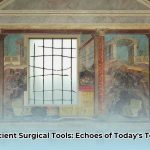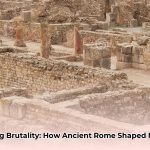Step into a bustling Roman valetudinarium, a military hospital, where the air hums with the metallic tang of iron and the earthy scent of herbs. Here, amidst the cries of wounded legionaries and the murmur of physicians, a world of sophisticated medical practice unfolds. While we might imagine ancient doctors relying solely on rudimentary practices, Roman medicine, shaped by centuries of Greek wisdom and the unrelenting demands of a vast empire, achieved remarkable advancements. This journey explores the actual tools Roman doctors wielded—scalpels, probes, and other instruments—revealing how their ingenuity laid foundational groundwork for many modern medical practices. Far from crude implements, these tools represented a calculated blend of practicality and innovation, heavily influenced by medical giants like Hippocrates and Galen. Examining ancient remedies shows how resourceful Roman medicine actually was.
Key Takeaways:
- Roman medicine developed advanced surgical techniques and instruments, significantly shaped by Greek medical knowledge, military demands, and a pragmatic understanding of the human body.
- Archaeological discoveries, notably from Pompeii and recent studies utilizing advanced scanning technologies, reveal a specialized arsenal, including scalpels, forceps, bone saws, and various specula.
- Despite lacking a modern understanding of germ theory, Roman hygiene practices, such as boiling tools, developing sophisticated sanitation systems like aqueducts and sewers, and the establishment of dedicated military hospitals, significantly reduced health risks and improved public welfare.
- The influence of Roman medical texts and public health initiatives endures, underscoring their lasting legacy on Western medicine.
The Roman Surgeon’s Arsenal: A Deeper Look at Their Tools
The world of ancient Roman surgical tools might seem distant, yet the innovations embedded within their design resonate profoundly in our modern medical practices. Archaeological discoveries, particularly renowned finds from Pompeii and recent studies, have unearthed a fascinating collection of instruments. Crafted predominantly from bronze, iron, and steel, these tools demonstrate a remarkable level of advancement and the pragmatic skill of Roman physicians. Their design often focused on ergonomics and multifunctionality, optimizing for real-world use in diverse medical scenarios, from battlefield triage to urban clinics.
- Scalpels: More than simple knives, Roman scalpels came in various forms, often featuring a steel blade inserted into a bronze handle. Some, known as “bellied scalpels,” had handles shaped to allow for more delicate and precise cuts, showcasing an early understanding of specialized surgical needs. These were used for everything from making incisions for surgery to therapeutic procedures like bloodletting.
- Forceps: These versatile tools, resembling modern tweezers or pliers, allowed surgeons to grasp, extract, and manipulate delicate tissues with precision. Different types existed, including finely toothed jawed forceps designed for specific procedures like the amputation of the uvula, where the tissue was crushed to prevent hemorrhage before excision. Many household forceps were also adapted for epilation or other non-medical uses.
- Bone Saws: A stark reminder of the era’s harsh realities, bone saws were essential for amputations, often necessitated by severe battlefield injuries, untreatable infections, or gangrene. Roman surgeons, influenced by Hippocrates, understood the need to tie off blood vessels with ligatures and remove diseased limbs to prevent further spread of infection, highlighting their grim determination to save lives under dire circumstances.
- Specula: Perhaps one of the most distinctive Roman medical instruments, the vaginal dilator or speculum (dioptra) comprised two (or sometimes three or four) dovetailing valves opened by a screw mechanism. This design, remarkably, persisted in Europe until the 18th century. Used for internal examinations to provide a clearer view of vaginal and uterine disorders, they also had rectal counterparts mentioned by Hippocrates for examining internal ulcers.
- Catheters: Addressing urinary problems even in antiquity, Roman catheters, commonly made from bronze, facilitated the relief of urinary retention and helped open blocked urinary tracts. This demonstrates an early focus on patient comfort and basic urological care.
- Probes (Spade-shaped probes or spathomeles): Slender probes, often with an olive-shaped end and a spatula at the other, allowed Roman surgeons to explore wounds, assess the extent of injuries, and guide their interventions. The spathomele was primarily a pharmaceutical instrument for mixing and spreading medicaments, but the olive end could also be used to explore body cavities.
- Bone Levers (Vectis): Essential for orthopedic procedures, bone levers were employed to manipulate and align fractured bones, aiming for proper healing and restoration of function. Galen described their use for levering fractured bones into position and even for tooth extraction. These instruments had ridged ends for better grip.
- Hooks: Both sharp and blunt hooks were frequently used. Blunt hooks served as probes for dissection and for raising blood vessels, similar to modern aneurysm needles. Sharp hooks were crucial for seizing and lifting small pieces of tissue for excision and for retracting the edges of wounds, demonstrating precise tissue management.
- Cauteries: Employed extensively, cauteries were devised in various forms and used for almost every purpose: as a counter-irritant, a hemostatic (to stop bleeding), a “bloodless knife,” and a means of destroying tumors. This highlights a versatile, if often painful, approach to managing tissue and bleeding.
- Bone Drills: Resembling corkscrews, bone drills were specifically used for the grim but necessary task of removing diseased bone tissue from the skull during procedures like trephination, or for extracting sizable foreign objects implanted in bone.
The intricate craftsmanship of these tools has been further illuminated by recent studies, such as those conducted at the University of Exeter using high-powered CT scanners on artifacts from the Walbrook River in London. These non-invasive techniques reveal minute details, like the precise socket for an iron scalpel blade designed for easy replacement, and even a secondary hole in a needle for a specific operation, underscoring the advanced design principles Roman artisans applied to medical instruments.
Beyond the Blade: Context of Roman Medical Practice
The efficacy of ancient Roman surgical tools was deeply intertwined with the prevailing medical theories, societal structure, and military necessities. Their understanding of health and disease, while different from ours, underpinned every medical intervention.
Greek Influences and Humoral Theory
Roman medicine did not develop in isolation. It was profoundly shaped by Greek medical thought, particularly the concept of humorism. This theory posited that the body’s health depended on maintaining a delicate balance among four essential fluids: blood, phlegm, yellow bile, and black bile. While now considered outdated, this theoretical framework guided Roman diagnoses and treatments for centuries. Prominent figures like Galen, a Greek physician who practiced extensively in Rome and served emperors, built upon this foundation, synthesizing Greek knowledge with Roman practical experience. His voluminous writings became authoritative texts for over a millennium.
Military Innovation and Public Health Foundations
The Roman army served as a significant crucible for medical advancement. Constant conflict demanded highly skilled surgeons capable of treating battlefield injuries effectively. Military hospitals, or valetudinaria, were established across the empire, providing dedicated, organized care for soldiers. These facilities were often staffed by specialized medici and chirurgi (wound doctors), leading to refined techniques in wound management, amputation, and fracture repair. The expertise gained here eventually diffused into civilian practices, improving overall healthcare for the populace. Interestingly, Roman military surgeons were only rivaled in skill by specialist arena surgeons, who dedicated themselves to repairing valuable gladiators.
Simultaneously, Roman engineering prowess significantly impacted public health. Their extensive aqueducts delivered clean water to cities, and sophisticated sewer systems managed waste, actively preventing waterborne diseases. This proactive approach to sanitation, though not fully grasping germ theory, directly contributed to a healthier population. Notably, the Romans were among the first to recognize that animals, like rodents, could transmit diseases to humans—a precursor to our modern understanding of zoonotic diseases. Public baths also played a crucial role in promoting personal hygiene, though they could sometimes be vectors for disease transmission themselves.
Pain Management and Ethical Realities
How did Roman physicians manage pain in an era without modern anesthetics? Historical texts, such as those by Pliny the Elder, document the use of various herbal remedies and compounds for pain relief, including those with potential opium-like properties gathered from poppies, and mandragora. While these offered some palliative effects, even minor procedures would have been excruciating by modern standards. The patient’s stoicism and endurance were often as crucial as the surgeon’s skill.
The “ethics” of Roman surgery must be viewed through their historical lens. Procedures like trepanation (drilling holes in the skull to relieve pain and pressure) might seem barbaric, yet evidence of new bone growth over the trephined areas indicates many patients survived. This procedure, explicated by Hippocrates, was performed to alleviate brain pressure after head injuries, demonstrating a pragmatic, life-saving effort. Similarly, amputations, while drastic, were often a last resort to prevent the spread of lethal gangrene or in response to severe industrial or war injuries. Alongside these practical, empirical approaches, religious beliefs and superstitions also played a role. Appeals to healing gods like Asclepius and Hygeia, alongside the use of amulets and rituals, were common in a holistic view of health that integrated the spiritual with the physical.
The Sterilization Riddle: Ancient Hygiene Practices
A critical question remains: how did Romans sterilize tools? While they lacked a comprehensive germ theory (the understanding that microorganisms cause disease), cleanliness was implicitly understood as crucial. Archaeological evidence and historical accounts suggest practices such as boiling surgical instruments and utilizing natural substances believed to possess antiseptic qualities, such as vinegar, wine, or even heat from fire. The air in a Roman military hospital, thick with the scent of herbs and the metallic tang of blood, buzzed with activity, yet surgeons understood the necessity of wiping down implements and maintaining a relatively clean environment for procedures. This rudimentary hygiene, though less effective than modern protocols, was a significant step toward infection control and highlights their dedication to preventing ailments.
A Lasting Legacy: Roman Medicine’s Enduring Impact
The direct and indirect impacts of ancient Roman surgical tools and practices are undeniable. Roman medical texts, particularly the extensive works of Galen and compilations by later writers like Paul of Aegina, remained authoritative for centuries, influencing medical education throughout the Middle Ages and Renaissance. Their emphasis on preventative care, balanced diet, and regular exercise continues to resonate in contemporary health recommendations. The very concept of public health, with its focus on widespread sanitation and access to clean water, is a direct inheritance from Roman engineering and civic foresight. The Roman commitment to detailed anatomical study, even if limited by societal norms restricting dissection, and their practical application of surgical knowledge set precedents that would shape subsequent medical advancements.
Their progress reminds us that medical advancement is a continuous process, built upon the foundations laid by those who came before. Even in the absence of modern technology, human ingenuity consistently finds ways to alleviate suffering and improve the quality of life. The echoes of Roman medical practices serve as a testament to the enduring human quest for solutions, across every era.
Here’s a comparison highlighting the evolution from ancient Roman medical practices to our modern applications:
| Aspect | Ancient Roman Medicine | Modern Medicine |
|---|---|---|
| Pain Relief | Herbal remedies (e.g., opium, mandragora), limited effectiveness. | Anesthesia (local, regional, general), sophisticated pain management specialists, targeted medications. |
| Hygiene | Basic understanding; boiling tools, use of wine/vinegar, aqueducts for clean water. | Strict sterilization protocols (autoclaving), advanced hygiene products, single-use instruments, aseptic surgical environments. |
| Surgical Complexity | Limited by technology, anatomical understanding, and pain management. | Highly complex procedures (organ transplants, microsurgery), advanced imaging guidance, robotic surgery. |
| Knowledge Source | Greek texts (Hippocrates, Galen), practical experience, some superstition. | Evidence-based research, extensive peer-reviewed literature, global collaboration, continuous scientific discovery. |
| Disease Theory | Humorism (bodily fluid imbalance), some recognition of environmental factors. | Germ theory, cellular biology, genetic understanding, immunology, molecular pathology. |
| Specialization | Limited; general surgeons, military medics, some herbalists. | Highly specialized fields (cardiology, neurology, oncology), multidisciplinary teams, sub-specialties. |
| Diagnostic Tools | Observation, physical examination, basic instruments (specula, probes). | Advanced imaging (X-rays, CT, MRI, ultrasound), lab tests, genetic testing, endoscopy. |
| Pharmaceuticals | Herbal remedies, natural substances, limited understanding of drug mechanisms. | Synthetic drugs, targeted therapies, personalized medicine, advanced drug delivery systems. |
| Public Health | Aqueducts, sanitation systems (sewers), public baths, military hospitals. | Vaccination programs, disease surveillance, stringent sanitation regulations, global health organizations. |
| Record Keeping | Primarily written accounts (often fragmented), limited systematic data collection. | Electronic health records, standardized coding, large-scale clinical trials, real-time data analysis. |
The journey from bronze scalpels to robotic surgery is vast, yet the fundamental drive to heal remains constant, echoing the ingenuity of those who came before us.










